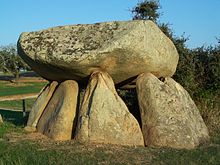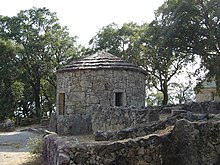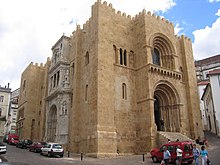Portuguese architecture refers to both the architecture of Portugal’s modern-day territory in Continental Portugal, the Azores and Madeira, as well as the architectural heritage/patrimony of Portuguese architects and styles throughout the world, particularly in countries formerly part of the Portuguese Empire.
Like all aspects of Portuguese culture, Portuguese architecture reflects the artistic influences of the various cultures that have either inhabited Portugal or come in contact with the Portuguese people throughout the history of Portugal, including the Gallaecians, Lusitanians, Celtiberians, Romans, Suebi, Visigoths, Moors, Goans, Macanese, Kristang people, and many more. Because of the history of the Portuguese Empire, several countries across the world are home to sizable heritages of Portuguese colonial architecture, notably Brazil and Uruguay in the Americas, Angola, Cabo Verde, São Tomé and Príncipe, Benin, Ghana, Morocco, Guinea Bissau, Zimbabwe, and Mozambique in Africa, and China, India, Indonesia, Malaysia, and Timor Leste in Asia.
Various artistic styles or movements have dominated Portuguese architecture throughout the ages, including Romanesque, Gothic, Manueline, Portuguese Renaissance, Portuguese Baroque, Rococo, Pombaline, Neo-Manueline, Soft Portuguese style, and contemporary architecture. Notable Portuguese architects of the past have included Diogo de Arruda (15–16th c.), João Antunes (17th c.), Eugénio dos Santos and Carlos Mardel (18th c.), José Luis Monteiro (19th c.), Raul Lino, Cassiano Branco and Fernando Távora (20th c.). Famous living architects include Gonçalo Byrne, Eduardo Souto de Moura (Pritzker winner), António Maria Braga, João Carrilho da Graça and Álvaro Siza Vieira (Priktzer winner).
History
Megalithic period

Neolithic dolmen in Alentejo.
The earliest examples of architectural activity in Portugal date from the Neolithic and consist of structures associated with Megalith culture. The Portuguese hinterland is dotted with a large number of dolmens (called antas or dólmens), tumuli (mamoas) and menhirs. The Alentejo region is particularly rich in megalithic monuments, like the notable Anta Grande do Zambujeiro, located near Évora. Standing stones can be found isolated or forming circular arrays (stone circles or cromlechs). The Almendres Cromlech, also located near Évora, is the largest of the Iberian Peninsula, containing nearly 100 menhirs arranged in two elliptical arrays on an east–west orientation.
Celtic period

Iron Age Castro at Citânia de Briteiros in Braga.
Celtic pre-historic fortified villages dating from the Chalcolithic are found along the Tagus river like that of Vila Nova de São Pedro, near Cartaxo, and the Castro of Zambujal, near Torres Vedras. These sites were occupied in the period around 2500–1700 BC and were surrounded by stone walls and towers, a sign of the conflicts of the time.
Starting around the 6th century BC, Northern Portugal, as well as neighbouring Galicia, saw the development of the Celtic Castro culture (cultura castreja). This region was dotted with hillfort villages (called citânias or cividades) that for the most part continued to exist under Roman domination, when the area became incorporated into the province of Gallaecia. Notable archaeological castro sites are the Citânia de Sanfins, near Paços de Ferreira, Citânia de Briteiros, near Guimarães, and the Cividade de Terroso, near Póvoa do Varzim. For defensive reasons, these hillforts were built over elevated terrain and were surrounded by rings of stone walls (Terroso had three wall rings). The houses inside the castros are about 3.5 to 5 meters long, mostly circular with some rectangular, stone-made and with thatch roofs which rested on a wood column in the centre of the building. Their streets are somewhat regular, suggesting some form of central organization. Baths were built in some of them, like in Briteiros and Sanfins.
Roman period

The Roman bridge of Aquae Flaviae, modern-day Chaves.
Architecture developed significantly in the 2nd century BC with the arrival of the Romans, who called the Iberian Peninsula Hispania. Conquered settlements and villages were often modernised following Roman models, with the building of a forum, streets, theatres, temples, baths, aqueducts and other public buildings. An efficient array of roads and bridges was built to link the cities and other settlements.

Roman Temple of Évora, 1st c.
Braga (Bracara Augusta) was the capital of the Gallaecia province and still has vestiges of public baths, a public fountain (called Idol’s Fountain) and a theatre. Évora boasts a well-preserved Roman temple, probably dedicated to the cult of Emperor Augustus. A Roman bridge crosses the Tâmega River by the city of Chaves (Aquae Flaviae). Lisbon (Olissipo) has the remains of a theatre in the Alfama neighbourhood.
The best-preserved remains of a Roman village are those of Conimbriga, located near Coimbra. The excavations revealed city walls, baths, the forum, an aqueduct, an amphitheatre, and houses for the middle classes (insulae), as well as luxurious mansions (domus) with central courtyards decorated with mosaics. Another important excavated Roman village is Miróbriga, near Santiago do Cacém, with a well preserved Roman temple, baths, a bridge and the vestiges of the only Roman hippodrome known in Portugal.
In the hinterland, wealthy Romans established villae, country houses dedicated to agriculture. Many villae contained facilities likes baths and were decorated with mosaics and paintings. Important sites are the Villae of Pisões (near Beja), Torre de Palma (near Monforte) and Centum Cellas (near Belmonte). The latter has the well-preserved ruins of a three-storey tower which was part of the residence of the villa owner.
Pre-Romanesque and Visigoth period
São Frutuoso Chapel, Braga 7th c.
Roman domination in Hispania was ended with the invasions by Germanic peoples (especially Sueves and Visigoths) starting in the 5th century AD. Very few buildings survive from the period of Visigoth domination (c.580–770), most of them modified in subsequent centuries. One of these is the small Saint Frutuoso Chapel, near Braga, which was part of a Visigothic monastery built in the 7th century. The building has a Greek cross floorplan with rectangular arms and a central cupola; both the cupola and the arms of the chapel are decorated with arch reliefs. The chapel shows clear influences of Byzantine buildings like the Mausoleum of Galla Placidia in Ravenna.
After 711, in the period of dominance of the Iberian Peninsula by the Moors, the Christian Kingdom of Asturias (c.711–910), located in the Northern part of the peninsula, was a centre of resistance (see Reconquista). In addition, many Christians (Mozarabs) lived in Moorish territories and were allowed to practice their religion and build churches. Asturian architecture and Mozarabic art influenced Christian buildings in the future Portuguese territory, as seen on the few structures that survived from this period. The most important of these is the Church of São Pedro de Lourosa, located near Oliveira do Hospital, which bears an inscription that gives 912 as the year of its construction. The church is a basilica with three aisles separated by horseshoe arches, a narthex on the façade and mullioned, horseshoe-shaped windows of Asturian influence on the central aisle.
Other pre-Romanesque churches broadly attributed to a mixture of Asturian and Mozarabic features are São Pedro de Balsemão, near Lamego, with a basilica floorplan, and the Chapel of São Gião, near Nazaré, all of which are disputed by some authors as buildings of Visigoth origin, having had additional features incorporated at a later stage. The inner spaces of these buildings are all divided by typical horseshoe arches. The Visigothic Saint Frutuoso Chapel was also modified in the 10th century, when the arm chapels were given a round floorplan and horseshoe arches.
Moorish period
Silves Castle in the Algarve, 8th c.
The invasion of the Iberian Peninsula in the year 711 by Moors from the Maghreb put an end to Visigoth rule in Hispania, called Al-Andalus by the newcomers. Moorish presence influenced art and architecture, especially in Southern Portugal, where the Reconquista was completed in 1249. Buildings during that period were often constructed with rammed earth (taipa) and adobe techniques, followed by whitewashing. Traditional houses in cities and villages in Portugal may have simple, white façades evoking Islamic influence. Some Southern neighbourhoods like the old Alfama district in Lisbon, have retained the street layouts from Muslim times. Contrasting with neighbouring Spain however, very few Islamic buildings in Portugal have survived intact to this day.
- Castles

Moorish arch in Mértola
Although many originated during the Islamic period, most Portuguese castles were extensively remodelled after the Christian reconquest. The best-preserved is Silves Castle, located in Silves, the ancient capital of the Al-Garb, today’s Algarve. Built between the 8th and 13th centuries, Silves Castle has preserved its walls and square-shaped towers from the Moorish period, as well as 11th-century cisterns – water reservoirs used in case of a siege. The old centre of the city – the Almedina – was defended by a wall and several fortified towers and gates, parts of which were preserved.

Castle of the Moors in Sintra
Another notable Islamic castle in the Algarve is Paderne Castle, whose ruined walls evidence the taipa building technique used in its construction. The Sintra Moorish Castle near Lisbon, has also kept some remains of walls and a cistern from that time. Part of the Moorish city walls have been preserved in Lisbon (the so-called Cerca Velha) and Évora, and Moorish city gates with a characteristic horseshoe-arched profile can be found in Faro and Elvas.
- Mosques
Many mosques were built in Portuguese territory during Muslim domination, but virtually all were either destroyed or altered and turned into churches and cathedrals. The cathedrals of Lisbon, Silves and Faro may have been built on the ruins of previous mosques after the Reconquista took hold.
The only clear example of a former mosque in Portugal is present-day Mértola’s Main Church, initially Mértola Mosque built in the 12th century. Once the village was reconquered, the mosque was partially altered and converted into a church. Its interior has a nearly square-shaped floorplan with 4 aisles, and a total of 12 columns supporting a subsequent 16th-century Manueline rib vaulting, modifications to the roof, and removal of aisles added Christian architectural features to the structure. Despite the changes, the original labyrinthic interior with its “forest” of pillars, three horseshoe arches with an alfiz the inner wall with a decorated niche, a mihrab pointing to Mecca, all show the same contemporary Islamic features found in Spain and the Mahgreb.
Portuguese Romanesque style
The Patriarchal Cathedral of Lisbon began construction in 1147.
The Romanesque style was introduced in Portugal between the end of the 11th and the beginning of the 12th century. The most influential of the first Portuguese Romanesque monuments were Braga Cathedral and the Monastery of Rates. The Cathedral of Braga was rebuilt in the 1070s by bishop Pedro and consecrated in 1089, although only the apse was finished at the time. The bishop’s ambitious plan was to create a pilgrimage church, with a three aisled nave, an ambulatory and a large transept. A relic of this early project may be a small Eastern chapel located nowadays outside the church itself.


Building activity gained pace after 1095, when Count Henry took possession of the Condado Portucalense. Count Henry came to Portugal with a number of noblemen and also Benedictine monks of Cluny Abbey, which was headed by Henry’s brother, Hugh. The Benedictines and other religious orders gave great impulse to Romanesque architecture during the whole 12th century. Count Henry sponsored the building of the Monastery of Rates (begun in 1096), one of the fundamental works of the first Portuguese Romanesque, although the project was modified several times during the 12th century. The relevance of its architecture and sculptures with diverse architectural influences make this temple a case study that is reflected in the production of further Romanesque art of the nascent kingdom of Portugal.
The worships of Braga and Rates were very influential in Northern Portugal. Extant 12th-century Romanesque monastic churches are found in Manhente (near Barcelos), with a portal dating from around 1117; Rio Mau (near Vila do Conde); with an exceptional apse dating from 1151; Travanca (near Amarante); Paço de Sousa (near Penafiel); Bravães (near Ponte da Barca), Pombeiro (near Felgueiras) and many others.
The spread of Romanesque in Portugal followed the North-South path of the Reconquista, specially during the reign of Afonso Henriques, Count Henry’s son and first King of Portugal. In Coimbra, Afonso Henriques created the Santa Cruz Monastery, one of the most important of the monastic foundations of the time, although the current building is the result of a 16th-century remodelling. Afonso Henriques and his successors also sponsored the building of many cathedrals in the bishop seats of the country. This generation of Romanesque cathedrals included the already-mentioned Braga, Oporto, Coimbra, Viseu, Lamego and Lisbon.
All Portuguese Romanesque cathedrals were later extensively modified with the exception of the Cathedral of Coimbra (begun 1162), which has remained unaltered. Coimbra Cathedral is a Latin cross church with a three-aisled nave, a transept with short arms and three East chapels. The central aisle is covered by a stone barrel vaulting while the lateral aisles are covered by groin vaults. The second storey of the central aisle has an arched gallery (triforium), and the crossing is topped by a dome. This general scheme is related to that of the Cathedral of Santiago de Compostela in Galicia, although the Coimbra building is much less ambitious.

Castle of the Counts of Ourém was built between the 12-15th centuries.

The fortress-like Old Cathedral of Coimbra began construction in 1139.
Lisbon Cathedral (begun c.1147) is very similar to Coimbra Cathedral, except that the West façade is flanked by two massive towers, a feature observed in other cathedrals like Oporto and Viseu. In general, Portuguese cathedrals had a heavy, fortress-like appearance, with crenellations and little decoration apart from portals and windows.
A remarkable religious Romanesque building is the Round Church (Rotunda) in the Castle of Tomar, which was built in the second half of the 12th century by the Templar Knights. The church is a round structure with a central arched octagon, and was probably modelled after the Dome of the Rock in Jerusalem, which was mistakenly believed by the crusaders to be a remnant of the Temple of Solomon. The Church of the Holy Sepulchre of Jerusalem may also have served as model.
- Castles
The troubled times of the Portuguese Reconquista meant that many castles had to be built to protect villages from Moor and Castilian attacks. King Afonso Henriques sponsored the building of many fortifications (often transforming Moorish castles such as Lisbon Castle) and granted land to Military Orders – specially the Templar Knights and the Knights Hospitallers – who became responsible for the defence of borders and villages. The Templar Knights built several fortresses along the line of the Tagus river, like the castles of Pombal, Tomar and Belver and Almourol. They are credited as having introduced the keep to Portuguese military architecture.
Gothic period


Gothic architecture was brought to Portugal by the Cistercian Order. The first fully Gothic building in Portugal is the church of the Monastery of Alcobaça, a magnificent example of the clear and simple architectural forms favoured by the Cistercians. The church was built between 1178 and 1252 in three phases, and seems inspired by the Abbey of Clairvaux, in the Champagne. Its three aisles are very tall and slender, giving an exceptional impression of height. The whole church is covered by rib vaulting and the main chapel has an ambulatory and a series of radiant chapels. The vault of the ambulatory is externally supported by flying buttresses, typical features of Gothic architecture and a novelty at the time in Portugal.
After the foundation of Alcobaça, the Gothic style was chiefly disseminated by mendicant orders (mainly Franciscan, Augustinians and Dominicans). Along the 13th and 14th centuries, several convents were founded in urban centres, important examples of which can be found in Oporto (São Francisco Church), Coimbra (Monastery of Santa Clara-a-Velha), Guimarães (São Francisco, São Domingos), Santarém (São Francisco, Santa Clara), Elvas (São Domingos), Lisbon (ruins of Carmo Convent) and many other places. Mendicant Gothic churches usually had a three-aisled nave covered with wooden roof and an apse with three chapels covered with rib vaulting. These churches also lacked towers and were mostly devoid of architectural decoration, in tone with mendicant ideals. Mendicant Gothic was also adopted in several parish churches built all over the country, for instance in Sintra (Santa Maria), Mafra, Lourinhã and Loulé.

Évora Cathedral, in the Alentejo, largely built from 1184-1380.
Many of the Romanesque cathedrals were modernised with Gothic elements. Thus, the Romanesque nave of Oporto Cathedral is supported by flying buttresses, one of the first built in Portugal (early 13th century). The apse of Lisbon Cathedral was totally remodelled in the first half of the 14th century, when it gained a Gothic ambulatory illuminated by a clerestory (high row of windows on the upper storey). The ambulatory has a series of radiant chapels illuminated with large windows, contrasting with the dark Romanesque nave of the cathedral.
-

Jesuit College of Ponta Delgada
-
Igreja do Espírito Santo
-

Ponta Delgada City Gates
-

Angra do Heroísmo City Hall
-
Ponta Delgada City Hall
-

Academy of Arts of the Azores
-
Town Hall of Ribeira Grande
Madeira and Porto Santo[edit]
-

Funchal City Hall
-

Typical thatch houses of Santana
-

Palace Fortress of São Lourenço
-

Museu Quinta das Cruzes
-

São Tiago Menor Church, Funchal
-

Largo do Phelps, Funchal
-
Institute of Madeira Wine







